国际经济学英文-大卫李嘉图模型
- 格式:ppt
- 大小:144.00 KB
- 文档页数:24
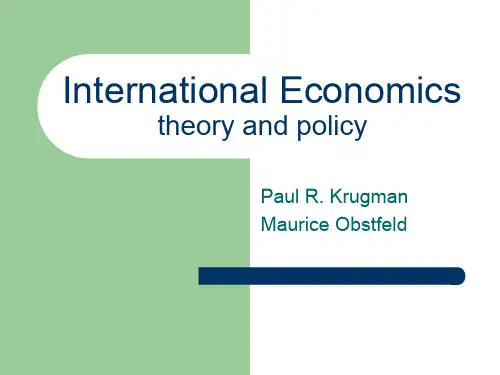
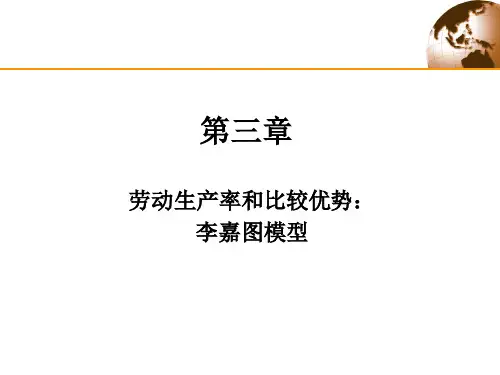
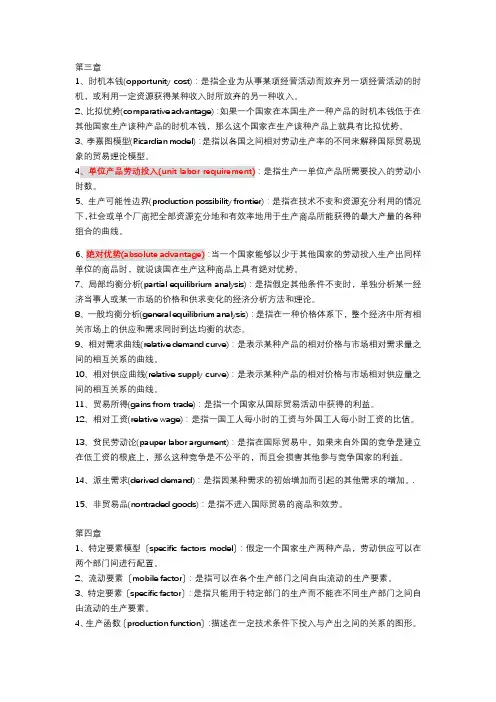
第三章1、时机本钱(opportunity cost):是指企业为从事某项经营活动而放弃另一项经营活动的时机,或利用一定资源获得某种收入时所放弃的另一种收入。
2、比拟优势(comparative advantage):如果一个国家在本国生产一种产品的时机本钱低于在其他国家生产该种产品的时机本钱,那么这个国家在生产该种产品上就具有比拟优势。
3、李嘉图模型(Ricardian model):是指以各国之间相对劳动生产率的不同来解释国际贸易现象的贸易理论模型。
4、单位产品劳动投入(unit labor requirement):是指生产一单位产品所需要投入的劳动小时数。
5、生产可能性边界(production possibility frontier):是指在技术不变和资源充分利用的情况下,社会或单个厂商把全部资源充分地和有效率地用于生产商品所能获得的最大产量的各种组合的曲线。
6、绝对优势(absolute advantage):当一个国家能够以少于其他国家的劳动投入生产出同样单位的商品时,就说该国在生产这种商品上具有绝对优势。
7、局部均衡分析(partial equilibrium analysis):是指假定其他条件不变时,单独分析某一经济当事人或某一市场的价格和供求变化的经济分析方法和理论。
8、一般均衡分析(general equilibrium analysis):是指在一种价格体系下,整个经济中所有相关市场上的供应和需求同时到达均衡的状态。
9、相对需求曲线(relative demand curve):是表示某种产品的相对价格与市场相对需求量之间的相互关系的曲线。
10、相对供应曲线(relative supply curve):是表示某种产品的相对价格与市场相对供应量之间的相互关系的曲线。
11、贸易所得(gains from trade):是指一个国家从国际贸易活动中获得的利益。
12、相对工资(relative wage):是指一国工人每小时的工资与外国工人每小时工资的比值。
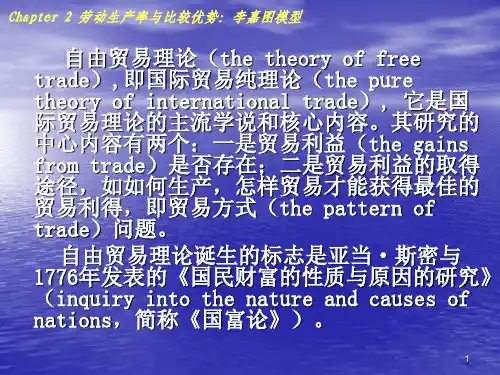
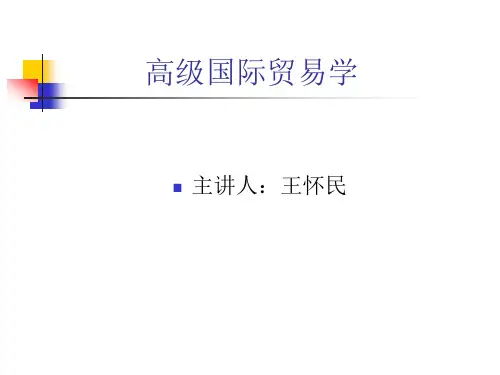
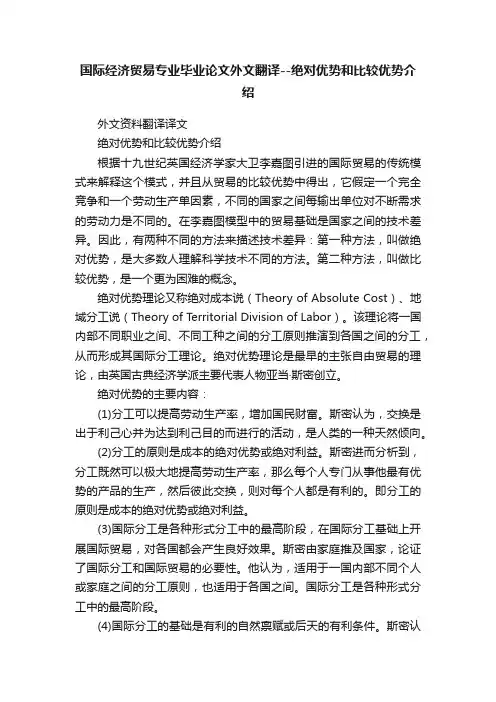
国际经济贸易专业毕业论文外文翻译--绝对优势和比较优势介绍外文资料翻译译文绝对优势和比较优势介绍根据十九世纪英国经济学家大卫李嘉图引进的国际贸易的传统模式来解释这个模式,并且从贸易的比较优势中得出,它假定一个完全竞争和一个劳动生产单因素,不同的国家之间每输出单位对不断需求的劳动力是不同的。
在李嘉图模型中的贸易基础是国家之间的技术差异。
因此,有两种不同的方法来描述技术差异:第一种方法,叫做绝对优势,是大多数人理解科学技术不同的方法。
第二种方法,叫做比较优势,是一个更为困难的概念。
绝对优势理论又称绝对成本说(Theory of Absolute Cost)、地域分工说(Theory of Territorial Division of Labor)。
该理论将一国内部不同职业之间、不同工种之间的分工原则推演到各国之间的分工,从而形成其国际分工理论。
绝对优势理论是最早的主张自由贸易的理论,由英国古典经济学派主要代表人物亚当·斯密创立。
绝对优势的主要内容:(1)分工可以提高劳动生产率,增加国民财富。
斯密认为,交换是出于利己心并为达到利己目的而进行的活动,是人类的一种天然倾向。
(2)分工的原则是成本的绝对优势或绝对利益。
斯密进而分析到,分工既然可以极大地提高劳动生产率,那么每个人专门从事他最有优势的产品的生产,然后彼此交换,则对每个人都是有利的。
即分工的原则是成本的绝对优势或绝对利益。
(3)国际分工是各种形式分工中的最高阶段,在国际分工基础上开展国际贸易,对各国都会产生良好效果。
斯密由家庭推及国家,论证了国际分工和国际贸易的必要性。
他认为,适用于一国内部不同个人或家庭之间的分工原则,也适用于各国之间。
国际分工是各种形式分工中的最高阶段。
(4)国际分工的基础是有利的自然禀赋或后天的有利条件。
斯密认为,有利的生产条件来源于有利的自然禀赋或后天的有利条件。
自然禀赋和后天的条件因国家而不同,这就为国际分工提供了基础。
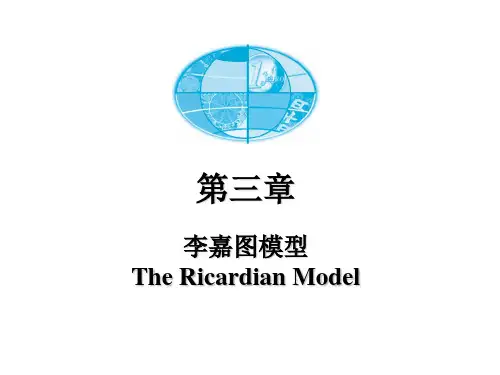
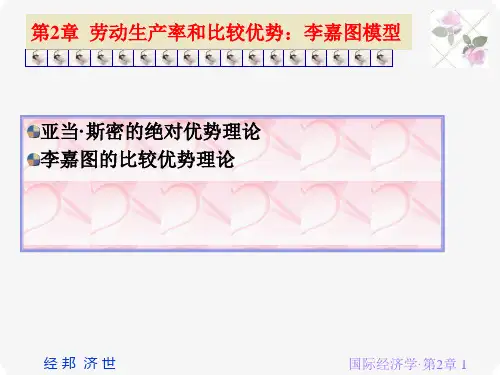

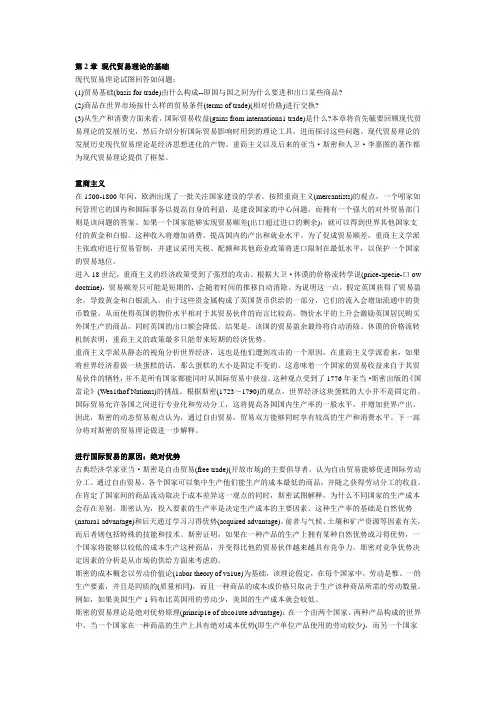
第2章现代贸易理论的基础现代贸易理论试图回答如问题:(1)贸易基础(basis for trade)由什么构成--即国与国之间为什么要进和出口某些商品?(2)商品在世界市场按什么样的贸易条件(terms of trade)(相对价格)进行交换?(3)从生产和消费方面来看,国际贸易收益(gains from internationa1 trade)是什么?本章将首先毓要回顾现代贸易理论的发展历史,然后介绍分析国际贸易影响时用到的理论工具,进而探讨这些问题。
现代贸易理论的发展历史现代贸易理论是经济思想进化的产物。
重商主义以及后来的亚当·斯密和人卫·李嘉图的著作都为现代贸易理论提供了框架。
重商主义在1500-1800年间,欧洲出现了一批关注国家建设的学者。
按照重商主义(mercantists)的观点,一个吲家如何管理它的国内和国际事务以提高自身的利益,是建设国家的中心问题,而拥有一个强大的对外贸易部门则是该问题的答案。
如果一个国家能够实现贸易顺差(出口超过进口的剩余),就可以得到世界其他国家支付的黄金和白银。
这种收入将增加消费,提高国内的产出和就业水平。
为了促成贸易顺差,重商主义学派主张政府进行贸易管制,并建议采用关税、配额和其他商业政策将进口限制在最低水平,以保护一个国家的贸易地位。
进入18世纪,重商主义的经济政策受到了强烈的攻击。
根据大卫·休谟的价格流转学说(price-specie-口ow doctrine),贸易顺差只可能是短期的,会随着时间的推移自动消除。
为说明这一点,假定英国获得了贸易盈余,导致黄金和白银流入。
由于这些贵金属构成了英国货币供给的一部分,它们的流入会增加流通中的货币数量,从而使得英国的物价水平相对于其贸易伙伴的而言比较高。
物价水平的上升会激励英国居民购买外国生产的商品,同时英国的出口额会降低。
结果是,该国的贸易盈余最终将自动消除。
休谟的价格流转机制表明,重商主义的政策最多只能带来短期的经济优势。
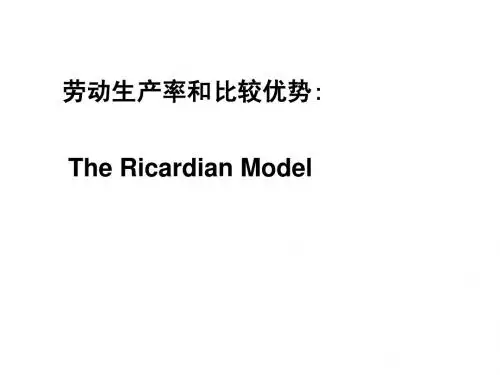
Chapter 3 The Ricardian ModelMultiple Choice Questions1.Countries trade with each other because they are _______ and because of______.A. different, costsB. similar, scale economiesC. different, scale economiesD. similar, costsE.None of the above.2.Trade between two countries can benefit both countries ifA.each country exports that good in which it has a comparativeadvantage.B.each country enjoys superior terms of trade.C.each country has a more elastic demand for the imported goods.D.each country has a more elastic supply for the supplied goods.E.Both C and D.3.The Ricardian theory of comparative advantage states that a country has acomparative advantage in widgets ifA.output per worker of widgets is higher in that country.B.that country's exchange rate is low.C.wage rates in that country are high.D.the output per worker of widgets as compared to the output of someother product is higher in that country.E.Both B and C.4.In order to know whether a country has a comparative advantage in theproduction of one particular product we need information on at least ____unit labor requirementsA.oneB.twoC.threeD.fourE.five5. A country engaging in trade according to the principles of comparativeadvantage gains from trade because itA.is producing exports indirectly more efficiently than it couldalternatively.B.is producing imports indirectly more efficiently than it coulddomestically.C.is producing exports using fewer labor units.D.is producing imports indirectly using fewer labor units.E.None of the above.6.In a two product two country world, international trade can lead to increasesinA.consumer welfare only if output of both products is increased.B.output of both products and consumer welfare in both countries.C.total production of both products but not consumer welfare in bothcountriesD.consumer welfare in both countries but not total production of bothproducts.E.None of the above.7. A nation engaging in trade according to the Ricardian model will find itsconsumption bundleA.inside its production possibilities frontier.B.on its production possibilities frontier.C.outside its production possibilities frontier.D.inside its trade-partner's production possibilities frontier.E.on its trade-partner's production possibilities frontier.8.In the Ricardian model, if a country's trade is restricted, this will cause allexcept which?A.Limit specialization and the division of labor.B.Reduce the volume of trade and the gains from tradeC.Cause nations to produce inside their production possibilities curvesD.May result in a country producing some of the product of itscomparative disadvantageE.None of the above.9.If a very small country trades with a very large country according to theRicardian model, thenA.the small country will suffer a decrease in economic welfare.B.the large country will suffer a decrease in economic welfare.C.the small country will enjoy gains from trade.D.the large country will enjoy gains from trade.E.None of the above.10.If the world terms of trade for a country are somewhere between the domesticcost ratio of H and that of F, thenA.country H but not country F will gain from trade.B.country H and country F will both gain from trade.C.neither country H nor F will gain from trade.D.only the country whose government subsidizes its exports will gain.E.None of the above.11.If the world terms of trade equal those of country F, thenA.country H but not country F will gain from trade.B.country H and country F will both gain from trade.C.neither country H nor F will gain from trade.D.only the country whose government subsidizes its exports will gain.E.None of the above.12.If the world terms of trade equal those of country ,F thenA.country H but not country F will gain from trade.B.country H and country F will both gain from trade.C.neither country H nor F will gain from trade.D.only the country whose government subsidizes its exports will gain.E.None of the above.13.The earliest statement of the principle of comparative advantage is associatedwithA.David Hume.B.David Ricardo.C.Adam Smith.D.Eli Heckscher.E.Bertil Ohlin.14.If one country's wage level is very high relative to the other's (the relativewage exceeding the relative productivity ratios), thenA.it is not possible that producers in each will find export marketsprofitable.B.it is not possible that consumers in both countries will enhance theirrespective welfares through imports.C.it is not possible that both countries will find gains from trade.D.it is possible that both will enjoy the conventional gains from trade.E.None of the above.15.The Ricardian model is based on all of the following exceptA.only two nations and two products.B. no diminishing returns.bor is the only factor of production.D.product quality varies among nations.E.None of the above.16.According to Ricardo, a country will have a comparative advantage in theproduct in which itsbor productivity is relatively low.bor productivity is relatively high.bor mobility is relatively low.bor mobility is relatively high.E.None of the above.17.Assume that labor is the only factor of production and that wages in the UnitedStates equal $20 per hour while wages in Japan are $10 per hour. Production costs would be lower in the United States as compared to Japan ifA.U.S. labor productivity equaled 40 units per hour and Japan's 15 unitsper hour.B.U.S. productivity equaled 30 units per hour whereas Japan's was 20.C.U.S. labor productivity equaled 20 and Japan's 30.D.U.S. labor productivity equaled 15 and Japan's 25 units per hour.E.None of the above.。